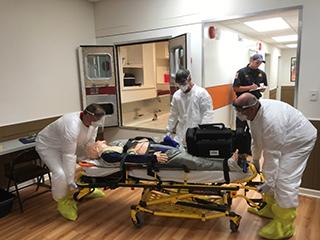
via NIEHS Grants- Stories of Success
Gregory D. Sempowski, Ph.D., is dedicated to helping workers protect themselves during infectious disease emergencies. He leads the Duke Infectious Disease Response Training (DIDRT) program, a five-state consortium funded by the NIEHS Worker Training Program (WTP), to provide up-to-date, high-quality, effective, and efficient biosafety and infectious disease response training.
Through a network of five training sites, the DIDRT Consortium provides training for workers in professions that may come in to contact with infectious agents such as Ebola and West Nile virus. This includes laboratory personnel and clinicians, as well as first responders, custodial workers, and air transport workers.
“Our number one priority is to provide training that makes people feel comfortable and confident that they are not at risk of getting sick while doing their job,” said Sempowski. “We have reached a variety of worker populations who may be exposed during infectious disease outbreaks and provided trainings on preventing spread or transmission in the event of an outbreak.”
Leveraging NIH Regional Biocontainment Infrastructure
The three-year DIDRT Consortium is based out of the Duke University Regional Biocontainment Laboratory (RBL), a high-containment research facility constructed by the NIH National Institute of Allergy and Infectious Diseases on the Duke Medical Center Campus. In 2017, Sempowski assumed directorship of the Duke RBL, which provides a contained and secure place to train people to work with infectious materials safely and to perform research on developing drugs, diagnostics, and vaccines against infectious diseases that impact global health. The RBL also serves as a resource in the event of a national or local emergency related to a bioterror attack or a large-scale outbreak.
“The consortium allowed us to take the expertise we have gained through our infectious disease research activities and formalize it into a high-quality training curriculum,” said Sempowski. The new consortium also provided an avenue to expand their reach across the U.S. through partnerships with four other high-containment facilities at the University of Chicago, George Mason University, University of Louisville, and Colorado State University.
Identifying Critical Needs
After they received funding for the DIDRT Consortium, Sempowski and his team of safety professionals started reaching out to laboratory workers and clinical providers to deliver training. They also began exploring other worker populations at risk of exposure to infectious agents. They have developed customized curricula for first responders, including police officers, firefighters, and emergency medical technicians, as well as for housekeeping staff, security staff, and U.S. Customs and Border Protection agents.
Through a better understanding of various worker populations and their unique needs, Sempowski and his colleagues have developed trainings specifically tailored to each group. For example, they found that English was not the primary language of the housekeeping staff at the University of Chicago but recognized that it was an important population that needed to be adequately trained. They adapted their curricula to replace much of the text with visual training tools and graphics. They found that hands-on trainings with visual aids were much more effective with this population than spoken word and written text.
“We bring a high level of risk assessment and risk analysis to the WTP by going to a worker population in a specific setting and assessing the specific risks that this population has,” Sempowski said. “We then customize our curricula to that learner population. We make sure we adapt to their work schedules, language skills, and educational levels. We customize every major training program along the way, which has helped add to our success.”
Managing High Quality Curricula
“We have very rigorous control over the training curriculum and the certification of our trainers such that we know they are all consistently training on the same curriculum, which we deliver through our cloud-based learning management system,” Sempowski added. “Through this on-line system, the network can expand and although the trainer may not report directly to us at Duke, we feel confident that they are communicating the information and following the approach to training that we implemented.”
All of their base curricula are available through the WTP National Clearinghouse, and they encourage all users to also reach out to a biosafety professional for additional guidance on tailoring the training to certain circumstances. They also have awareness level courses available globally to anyone who registers on their learning management system portal.
“The program has brought to the forefront the importance of infectious disease response training, that these are hazards that are out there and people need to be trained to address them,” said Sempowski. Sempowski and his team have created curricula for a wider worker pool and have provided at least awareness level training to populations who had not previously received it.
“Infectious disease response training is not required for many of these worker populations and we find that people are generally not willing to pay for optional trainings,” Sempowski added. “NIEHS funding for the DIDRT program was a tremendous boost to help provide high quality trainings to broader populations free of charge. We hope to continue this program moving forward in order to make people more comfortable in their daily work.”